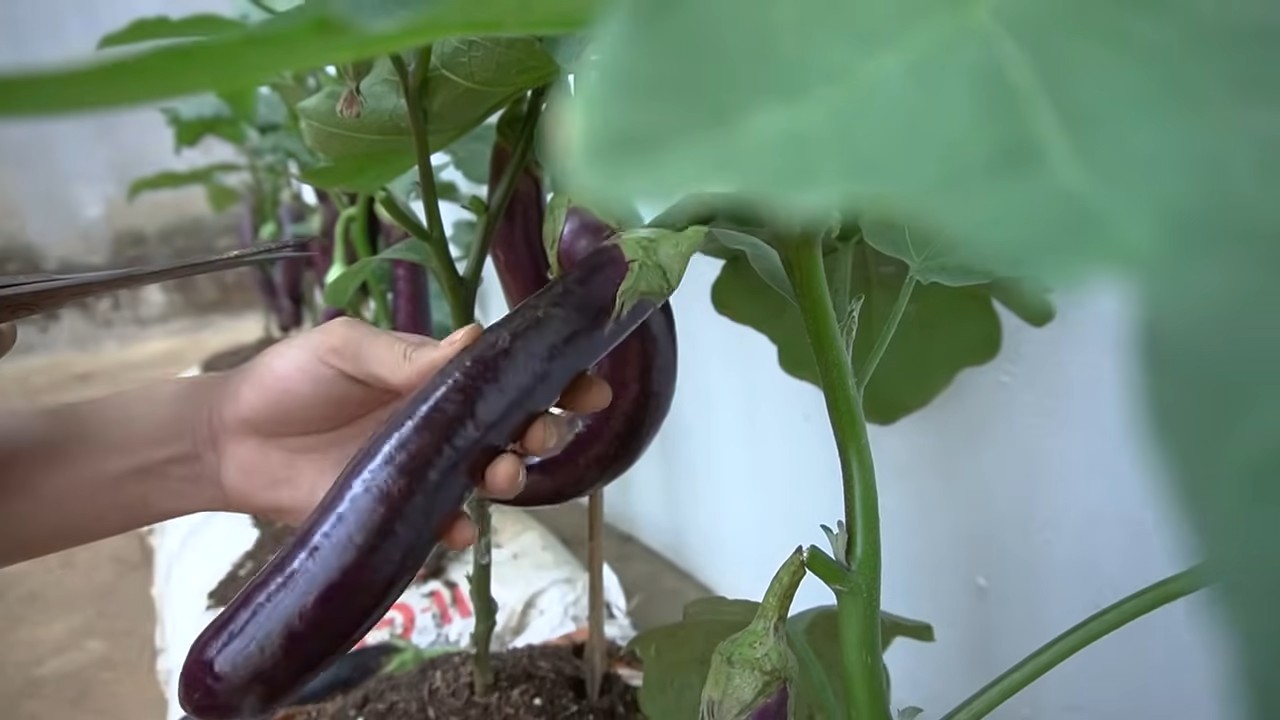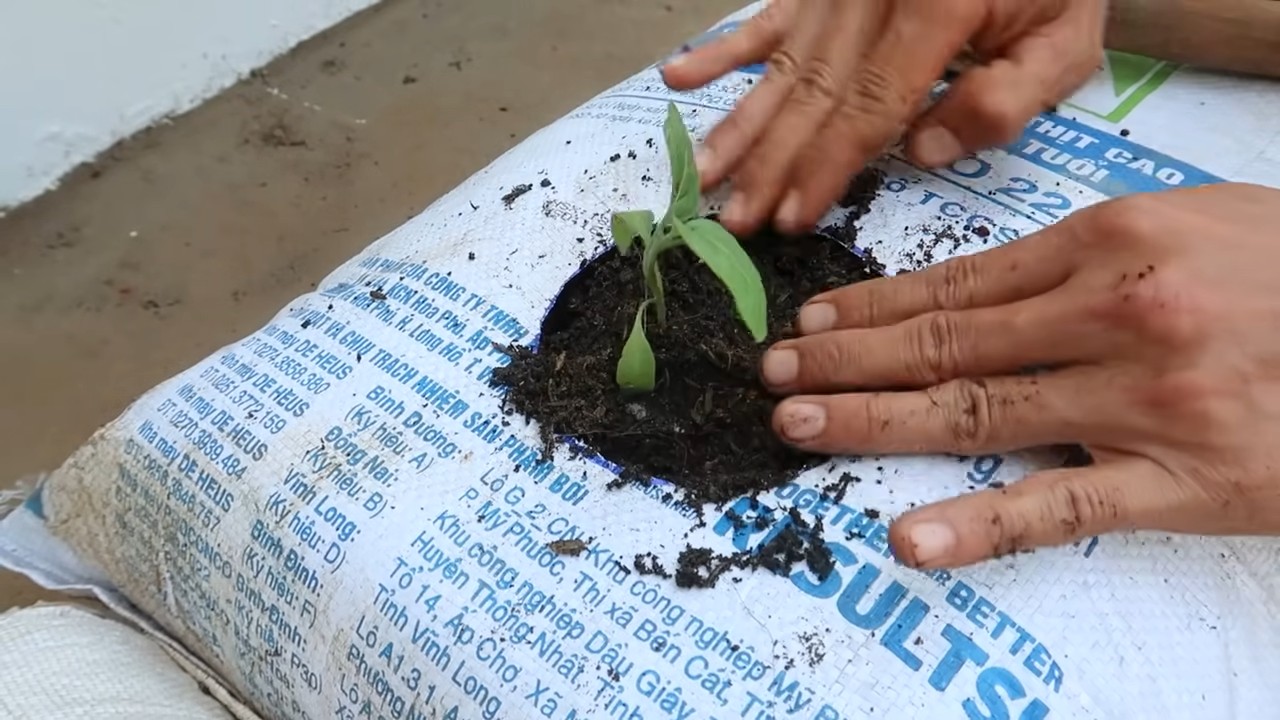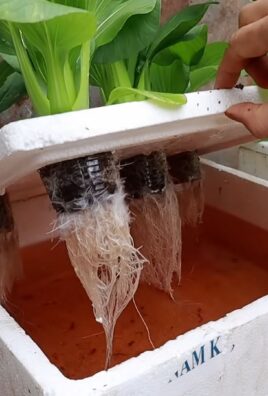Growing Eggplants at Home can seem daunting, but trust me, with a few simple tricks and a little DIY magic, you can be harvesting your own delicious, glossy eggplants in no time! Imagine serving up a homemade eggplant parmesan, knowing you nurtured those beauties from tiny seedlings right in your own backyard. That’s the kind of satisfaction we’re aiming for!
Eggplants, also known as aubergines, have a rich history, dating back thousands of years to ancient Asia. They were initially cultivated for medicinal purposes before becoming a culinary staple. Different cultures have embraced the eggplant in countless ways, from the hearty moussaka of Greece to the spicy curries of India. Now, it’s your turn to add your own chapter to the eggplant story!
Why should you bother with these DIY tricks? Well, let’s face it, store-bought eggplants can be expensive and sometimes lack that fresh, vibrant flavor. Plus, growing eggplants at home allows you to control exactly what goes into your food, avoiding harmful pesticides and ensuring the best possible taste. I’m going to share some easy-to-follow tips and hacks that will help you overcome common challenges, like pest control and maximizing your yield. Get ready to unleash your inner gardener and enjoy the fruits (or rather, vegetables!) of your labor!

Auberginen selbst anbauen: Dein umfassender DIY-Leitfaden
Hey Gartenfreunde! Ich liebe Auberginen, und es gibt nichts Besseres, als sie frisch aus dem eigenen Garten zu ernten. Der Anbau von Auberginen mag anfangs etwas einschüchternd wirken, aber mit der richtigen Anleitung und ein wenig Geduld kann jeder diesen köstlichen Gemüse selbst anbauen. In diesem Artikel zeige ich dir Schritt für Schritt, wie du erfolgreich Auberginen zu Hause anbauen kannst. Los geht’s!
Was du für den Auberginenanbau brauchst
Bevor wir loslegen, hier eine Liste der Dinge, die du benötigst:
* Auberginensamen oder Jungpflanzen (ich empfehle, mit Jungpflanzen zu beginnen, wenn du wenig Erfahrung hast)
* Anzuchttöpfe oder -schalen
* Anzuchterde
* Größere Töpfe (mindestens 30 cm Durchmesser) oder ein sonniger Platz im Gartenbeet
* Gute Gartenerde oder Kompost
* Pflanzdünger (speziell für Gemüse)
* Gießkanne oder Gartenschlauch
* Pflanzstäbe oder Rankgitter (Auberginenpflanzen können ziemlich groß werden und Unterstützung benötigen)
* Gartenschere
* Handschuhe
* Geduld und Liebe!
Auberginen vorziehen (optional, aber empfohlen)
Wenn du mit Samen beginnst, ist das Vorziehen der Pflanzen im Haus eine gute Idee, besonders wenn du in einer Region mit kurzen Sommern lebst.
1. Samen aussäen: Fülle deine Anzuchttöpfe mit Anzuchterde. Drücke die Erde leicht an und säe die Auberginensamen etwa 0,5 cm tief ein. Gib jedem Topf ein bis zwei Samen.
2. Gießen: Befeuchte die Erde vorsichtig mit einer Sprühflasche oder einer Gießkanne mit feinem Brausekopf. Die Erde sollte feucht, aber nicht nass sein.
3. Wärme und Licht: Stelle die Töpfe an einen warmen Ort (idealerweise 24-29°C). Ein beheiztes Zimmergewächshaus oder eine Heizmatte können hier sehr hilfreich sein. Sobald die Samen keimen (das dauert in der Regel 1-2 Wochen), stelle die Töpfe an einen hellen Ort, z.B. auf eine sonnige Fensterbank oder unter eine Pflanzenlampe.
4. Pflege: Halte die Erde feucht, aber vermeide Staunässe. Wenn mehr als ein Samen pro Topf gekeimt ist, entferne den schwächeren Sämling, damit der stärkere genug Platz hat.
5. Pikieren: Sobald die Sämlinge ihre ersten “echten” Blätter (nicht die Keimblätter) entwickelt haben, kannst du sie in größere Töpfe pikieren. Fülle die größeren Töpfe mit Gartenerde oder Kompost und pflanze die Sämlinge vorsichtig um.
Auberginen auspflanzen (ins Beet oder in Töpfe)
Sobald die Auberginenpflanzen kräftig genug sind und keine Frostgefahr mehr besteht (in der Regel Mitte Mai), können sie ins Freie gepflanzt werden.
1. Abhärten: Bevor du die Pflanzen ins Freie pflanzt, solltest du sie etwa eine Woche lang abhärten. Stelle sie tagsüber für ein paar Stunden nach draußen und hole sie abends wieder rein. So gewöhnen sie sich langsam an die Bedingungen im Freien.
2. Standort vorbereiten: Wähle einen sonnigen Standort mit gut durchlässigem Boden. Auberginen lieben Wärme und brauchen mindestens 6-8 Stunden Sonne pro Tag. Lockere den Boden auf und mische Kompost oder gut verrotteten Mist unter, um ihn mit Nährstoffen anzureichern.
3. Pflanzen: Grabe Löcher, die etwas größer sind als die Wurzelballen der Auberginenpflanzen. Setze die Pflanzen vorsichtig in die Löcher und fülle sie mit Erde auf. Achte darauf, dass die Oberseite des Wurzelballens mit der Erdoberfläche abschließt.
4. Abstand: Halte einen Abstand von etwa 45-60 cm zwischen den Pflanzen ein, damit sie genügend Platz zum Wachsen haben.
5. Gießen: Gieße die Pflanzen nach dem Einpflanzen gründlich an.
6. Stützen: Setze Pflanzstäbe neben die Pflanzen oder installiere ein Rankgitter, um sie zu stützen, wenn sie größer werden. Auberginenpflanzen können unter dem Gewicht der Früchte leicht umknicken.
Auberginen pflegen: Gießen, Düngen, Schneiden
Die richtige Pflege ist entscheidend für eine reiche Auberginenernte.
1. Gießen: Auberginen brauchen regelmäßig Wasser, besonders während der Fruchtbildung. Gieße sie am besten morgens, damit die Blätter tagsüber abtrocknen können und Pilzkrankheiten vermieden werden. Vermeide Staunässe.
2. Düngen: Dünge die Auberginenpflanzen alle 2-3 Wochen mit einem speziellen Gemüsedünger. Befolge dabei die Anweisungen auf der Verpackung. Du kannst auch organischen Dünger wie Komposttee verwenden.
3. Mulchen: Eine Mulchschicht aus Stroh oder Rasenschnitt hilft, die Feuchtigkeit im Boden zu halten, Unkraut zu unterdrücken und den Boden zu düngen.
4. Schneiden: Das Ausgeizen der Auberginenpflanzen kann die Ernte verbessern. Entferne Seitentriebe, die zwischen dem Hauptstamm und den Blättern wachsen. So konzentriert sich die Pflanze auf die Entwicklung der Früchte. Entferne auch gelbe oder beschädigte Blätter.
5. Schädlinge und Krankheiten: Achte auf Schädlinge wie Blattläuse, Kartoffelkäfer und Spinnmilben. Bei Befall kannst du natürliche Schädlingsbekämpfungsmittel wie Neemöl oder Insektizidseife verwenden. Auberginen können auch von Pilzkrankheiten wie Mehltau befallen werden. Sorge für eine gute Belüftung der Pflanzen und vermeide es, die Blätter beim Gießen zu benetzen.
Auberginen ernten
Die Erntezeit ist der schönste Teil!
1. Reife erkennen: Auberginen sind erntereif, wenn sie ihre volle Farbe erreicht haben und sich fest anfühlen. Die Schale sollte glänzend sein. Drücke leicht auf die Frucht; wenn sie leicht nachgibt, ist sie reif.
2. Ernten: Schneide die Auberginen mit einer Gartenschere ab. Lasse dabei einen kleinen Stiel an der Frucht.
3. Regelmäßig ernten: Ernte die Auberginen regelmäßig, um die Pflanze zur Bildung neuer Früchte anzuregen.
Sortenempfehlungen
Es gibt viele verschiedene Auberginensorten, die sich in Form, Farbe und Geschmack unterscheiden. Hier sind ein paar meiner Favoriten:
* Black Beauty: Eine klassische, dunkelviolette Sorte mit einem milden Geschmack.
* Ichiban: Eine schlanke, japanische Sorte mit einer zarten Schale und einem süßen Geschmack.
* Rosa Bianca: Eine wunderschöne, rosa-weiß gestreifte Sorte mit einem cremigen Fruchtfleisch.
* Thai Green: Kleine, grüne Auberginen mit einem leicht bitteren Geschmack.
Häufige Probleme und Lösungen
Auch beim Auberginenanbau können Probleme auftreten. Hier sind ein paar häufige Probleme und wie du sie lösen kannst:
* Blütenfall: Wenn die Blüten abfallen, ohne Früchte zu bilden, kann das an zu hohen oder zu niedrigen Temperaturen, Wassermangel oder Nährstoffmangel liegen. Sorge für optimale Bedingungen und dünge die Pflanzen regelmäßig.
* Kleine Früchte: Wenn die Früchte klein bleiben, kann das an zu wenig Sonne, zu wenig Wasser oder zu wenig Dünger liegen. Sorge für ausreichend Sonne, gieße regelmäßig und dünge die Pflanzen.
* Schädlinge: Kontrolliere die Pflanzen regelmäßig auf Schädlinge und bekämpfe sie bei Bedarf mit natürlichen Mitteln.
Zusätzliche Tipps für eine reiche Ernte
* Fruchtfolge: Baue Auberginen nicht jedes Jahr am selben Standort an, um Krankheiten und Schädlingen vorzubeugen.
* Begleitpflanzen: Pflanze Basilikum, Ringelblumen oder Knoblauch neben Auberginen,

Conclusion
So, there you have it! Growing eggplants at home might seem daunting at first, but with the right knowledge and a little patience, you can enjoy a bountiful harvest of these versatile vegetables right from your own backyard. We’ve covered everything from seed starting and transplanting to pest control and harvesting, equipping you with the essential tools to succeed.
Why is this DIY trick a must-try? Because nothing beats the flavor of a homegrown eggplant, bursting with freshness and free from the chemicals often found in commercially grown produce. Plus, you have complete control over the growing process, ensuring the best possible quality and taste. Imagine the satisfaction of serving a delicious eggplant parmesan made with eggplants you nurtured from tiny seeds!
But the journey doesn’t end here. Feel free to experiment with different eggplant varieties. Try growing the classic Black Beauty, the slender Japanese eggplant, or even the vibrant Thai eggplant. Each variety offers a unique flavor and texture, adding exciting dimensions to your culinary creations.
Consider companion planting to further enhance your eggplant garden. Basil, marigolds, and thyme are excellent choices, attracting beneficial insects and repelling pests naturally. You can also explore different growing methods, such as container gardening or raised beds, depending on your space and preferences.
Don’t be afraid to get your hands dirty and embrace the learning process. Gardening is all about experimentation and discovery. You might encounter challenges along the way, but with perseverance and a willingness to adapt, you’ll be rewarded with a thriving eggplant garden.
We wholeheartedly encourage you to try growing eggplants at home. It’s a rewarding experience that connects you with nature, provides you with fresh, healthy food, and allows you to unleash your inner gardener. And most importantly, you’ll be able to enjoy the unparalleled taste of homegrown eggplants in your favorite dishes.
Once you’ve embarked on your eggplant-growing adventure, we’d love to hear about your experiences! Share your tips, successes, and challenges in the comments below. Let’s create a community of eggplant enthusiasts, learning from each other and celebrating the joys of homegrown produce. Your insights could inspire others to take the plunge and discover the magic of growing their own food. So, grab your seeds, prepare your soil, and get ready to experience the satisfaction of harvesting your very own delicious, homegrown **eggplants**. Happy gardening!
Frequently Asked Questions (FAQ)
1. How long does it take to grow eggplants from seed to harvest?
The time it takes to grow eggplants from seed to harvest can vary depending on the variety, climate, and growing conditions. Generally, it takes about 60 to 80 days from transplanting seedlings to harvesting mature eggplants. Starting seeds indoors 6-8 weeks before the last expected frost can give you a head start. Keep in mind that cooler temperatures can slow down growth, while warmer temperatures can accelerate it. Consistent watering and fertilization are also crucial for optimal growth and a timely harvest.
2. What are the most common pests and diseases that affect eggplants, and how can I control them?
Eggplants are susceptible to several pests and diseases, including aphids, flea beetles, spider mites, tomato hornworms, and verticillium wilt.
* **Aphids:** These tiny insects suck sap from plants, causing stunted growth and distorted leaves. Control them with insecticidal soap, neem oil, or by introducing beneficial insects like ladybugs.
* **Flea Beetles:** These small, jumping beetles create small holes in the leaves. Use row covers to protect young plants, or apply diatomaceous earth around the base of the plants.
* **Spider Mites:** These tiny mites create webbing on the undersides of leaves, causing them to turn yellow and dry out. Control them with insecticidal soap, neem oil, or by increasing humidity around the plants.
* **Tomato Hornworms:** These large caterpillars can quickly defoliate eggplant plants. Handpick them off the plants or use Bacillus thuringiensis (Bt), a natural insecticide.
* **Verticillium Wilt:** This soilborne fungal disease causes wilting and yellowing of leaves, eventually leading to plant death. Choose disease-resistant eggplant varieties, practice crop rotation, and avoid overwatering.
Regularly inspect your plants for signs of pests and diseases, and take action promptly to prevent infestations from spreading.
3. How often should I water my eggplant plants?
Eggplant plants need consistent moisture, especially during hot weather and fruit development. Water deeply and regularly, aiming for about 1-2 inches of water per week. Water at the base of the plants to avoid wetting the foliage, which can increase the risk of fungal diseases. Check the soil moisture regularly by sticking your finger about an inch into the soil. If it feels dry, it’s time to water. Mulching around the plants can help retain moisture and suppress weeds.
4. What kind of fertilizer should I use for eggplants?
Eggplants are heavy feeders and benefit from regular fertilization. Use a balanced fertilizer with equal amounts of nitrogen, phosphorus, and potassium (e.g., 10-10-10) at planting time. Once the plants start producing fruit, switch to a fertilizer with a higher phosphorus content (e.g., 5-10-5) to promote fruit development. You can also supplement with compost tea or liquid seaweed extract to provide additional nutrients and micronutrients. Avoid over-fertilizing, as this can lead to excessive foliage growth and reduced fruit production.
5. How do I know when my eggplants are ripe and ready to harvest?
Eggplants are typically ready to harvest when they are firm, glossy, and have reached their mature size and color. The skin should be smooth and unblemished. Gently press the skin with your thumb; if it leaves a slight indentation, the eggplant is ripe. Overripe eggplants will become dull, soft, and seedy. Use a sharp knife or pruning shears to cut the eggplant from the plant, leaving a short stem attached.
6. Can I grow eggplants in containers?
Yes, eggplants can be successfully grown in containers, making them a great option for gardeners with limited space. Choose a large container (at least 5 gallons) with good drainage. Use a high-quality potting mix and provide regular watering and fertilization. Select compact or dwarf eggplant varieties that are well-suited for container growing. Place the container in a sunny location that receives at least 6-8 hours of sunlight per day.
7. What are some good companion plants for eggplants?
Companion planting can benefit eggplants by attracting beneficial insects, repelling pests, and improving soil health. Some good companion plants for eggplants include:
* **Basil:** Repels aphids, spider mites, and tomato hornworms.
* **Marigolds:** Repel nematodes and other soil pests.
* **Thyme:** Repels cabbage moths and other pests.
* **Beans:** Fix nitrogen in the soil, benefiting eggplant growth.
* **Peppers:** Can provide shade and support for eggplants.
Avoid planting eggplants near fennel, as it can inhibit their growth.
8. How can I prevent blossom end rot in eggplants?
Blossom end rot is a common problem in eggplants, characterized by a dark, sunken spot on the bottom of the fruit. It is caused by a calcium deficiency, often due to inconsistent watering or poor soil drainage. To prevent blossom end rot:
* Ensure consistent watering, especially during hot weather.
* Improve soil drainage by adding organic matter.
* Test your soil and amend with lime if it is acidic.
* Use a calcium-rich fertilizer or foliar spray.
* Mulch around the plants to retain moisture and regulate soil temperature.
9. Can I save eggplant seeds for next year?
Yes, you can save eggplant seeds for next year, but keep in mind that hybrid varieties may not produce true-to-type offspring. To save seeds, allow the eggplants to fully ripen on the plant until they become dull and soft. Cut open the eggplant and scoop out the seeds. Rinse the seeds thoroughly to remove any pulp. Spread the seeds on a paper towel to dry completely. Store the dried seeds in an airtight container in a cool, dark, and dry place.
10. What are some creative ways to use homegrown eggplants in cooking?
Homegrown eggplants are incredibly versatile and can be used in a wide variety of dishes. Some creative ways to use them include:
* **Eggplant Parmesan:** A classic Italian dish with layers of fried eggplant, tomato sauce, and cheese.
* **Baba Ghanoush:** A Middle Eastern dip made with roasted eggplant, tahini, lemon juice, and garlic.
* **Eggplant Curry:** A flavorful and aromatic curry with eggplant, spices, and coconut milk.
* **Grilled Eggplant:** A simple and delicious way to enjoy the natural flavor of eggplant.
* **Eggplant Pizza:** Use slices of grilled eggplant as a base for pizza toppings.
* **Stuffed Eggplant:** Hollow out eggplants and fill them with a mixture of rice, vegetables, and meat.
Don’t be afraid to experiment and try new recipes with your homegrown eggplants!




Leave a Comment